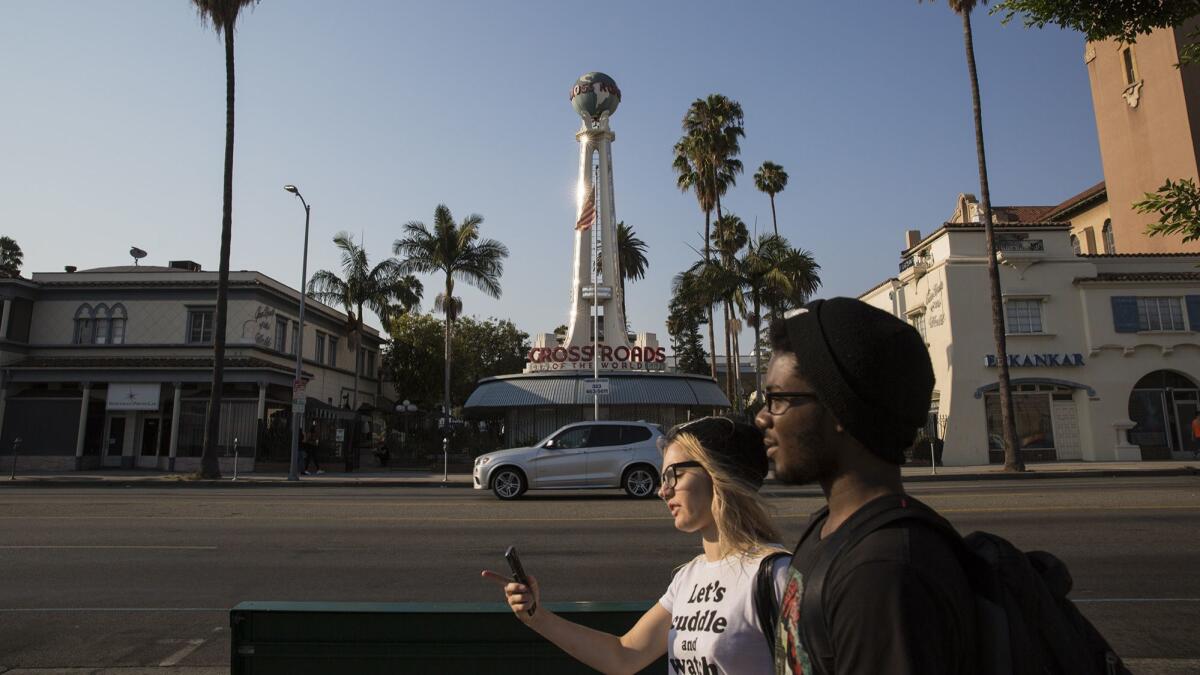L.A. officials back three-tower Hollywood project with 950 apartments
The Los Angeles City Planning Commission voted Thursday to endorse the sprawling project known as Crossroads Hollywood, a campus offering 950 new apartments and a 308-room hotel on or near Sunset Boulevard.
The panel, made up of appointees of Mayor Eric Garcetti, recommended the project to the City Council despite warnings that it would flood the neighborhood with thousands of additional cars and result in the demolition of dozens of rent-controlled apartments.
The $1-billion Crossroads project calls for nine new structures, including a 26-story hotel and two residential towers — one at 30 stories, the other 31. It would also add 190,000 square feet of commercial space, including a new movie theater, to the 8.3-acre site.
Opponents said such a huge development would have serious impacts on traffic, historic preservation and other neighborhood issues.
“It’s going to turn Sunset Boulevard into a parking lot,” said Doug Carstens, a lawyer who represents Livable L.A., one of the groups that oppose the project. “They’ve got four major intersections on Sunset with what they call unavoidable impacts. But they’d be avoidable if they reduced the size of the project.”

Planning officials said Crossroads Hollywood will be in an area served by several bus routes and a Metro Red Line subway station. Because it is so close to so many forms of public transit, and because of the way it is designed, Crossroads Hollywood will result in 36% fewer “vehicle miles traveled” when compared with another development of the same size, said Kyndra Casper, an attorney for Harridge Development Group.
Planning Commissioner David Ambroz said Crossroads Hollywood would go up in a part of the city where high-density housing makes sense. He accused the project’s opponents of misusing the California Environmental Quality Act, or CEQA, and said his time had been “wasted” reading through the paperwork they submitted.
“They once again abuse CEQA to delay and deny people the right to develop property,” Ambroz said. “It would be nice to sit up here one day when I saw CEQA used to help the environment, as opposed to extort developers.”
Supporters of Crossroads Hollywood say it would create much-needed housing and inject new life into a part of Hollywood in need of revitalization. They praised Harridge for seeking to preserve some of the buildings on the site, including those that make up Crossroads of the World — which opened in the mid-1930s as an outdoor shopping area and is known for its rotating globe.
Foes of the development said those preservation efforts did not go far enough, arguing that additional structures should have been protected. They criticized Harridge for seeking to demolish 82 rent-controlled apartments on the site, saying such a move would accelerate gentrification in Hollywood.
“We’re not a fan of the Disneyfication of Sunset,” said Ged Kenslea, spokesman for the AIDS Healthcare Foundation, which opposes the Crossroads project. “They’re destroying one community to create another community.”
Kenslea also called Ambroz’s comments “disrespectful” to the public.
Representatives of Harridge said their project will set aside 105 apartments for very low-income residents, those who earn up to 50% of the L.A.-Long Beach area’s median income. The company also agreed to allow the roughly 40 people who still live on the site to move into Crossroads Hollywood once it is completed — at nearly the same rent they are paying now, Casper said.
Some commissioners, concerned about the loss of rent-controlled units, pushed unsuccessfully for Harridge to increase the number of subsidized apartments on the site. But commission President Samantha Millman opposed that move, saying the developer had gone a long way to make sure “every single resident of this project is taken care of.”
Commissioner Karen Mack commended Harridge for working closely with the surrounding community. But she acknowledged having lingering worries about the traffic congestion that would accompany the project.
Angelenos, she said, are dreaming of a future when the city will have several new rail lines, “where we don’t have to get in a car and we can hop on the Metro.”
“In the meantime,” she said, “you’re sitting in traffic. And you hate living in L.A. at that moment.”
Twitter: @DavidZahniser
More to Read
Start your day right
Sign up for Essential California for news, features and recommendations from the L.A. Times and beyond in your inbox six days a week.
You may occasionally receive promotional content from the Los Angeles Times.







